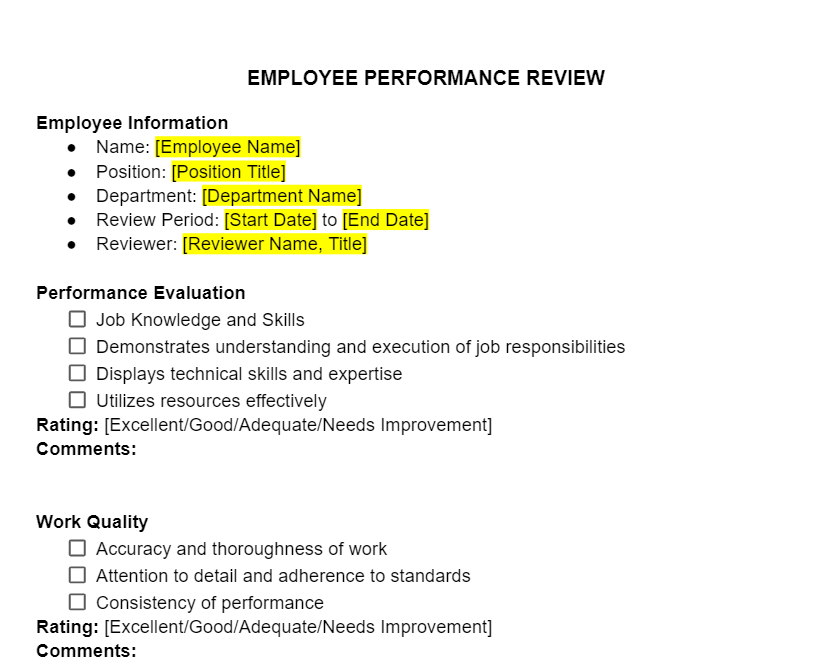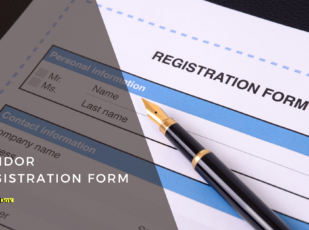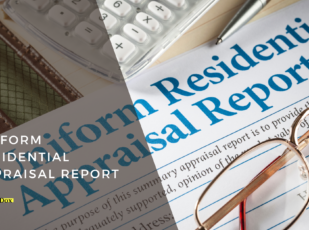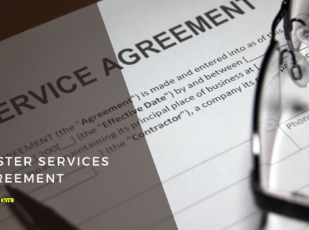
Employee Performance Review Template
9 Downloads
Employment
January 7, 2025
Sayantani Dutta
Time for review! Every organization relies on its workforce. More importantly, it depends on its workforce doing work that meets the quality and quantity expectations. That is the only way to grow, after all. And for that reason, the organization analyzes job performance using various metrics. Often, it will also set goals or remark where there is room for improvement. This is called performance evaluation.
But a common pain point of the organizational performance review process is that the employee’s strengths are not comparable to others, or others before/after them. This happens mainly because the metrics or processes change over time.
Enter the Employee Performance Review Template—a core document that can be used to make your organizational data comparable and future-proof. A comprehensive template is an excellent way to start performance reviews and have a robust evaluation process that can yield valuable data.
Direct reports for the professional development of the team members and remarks about areas of improvement not only help you develop a rating system and compare key competencies, but they also aid in the career development prospects of the employees with constructive feedback.
Thus, the Employee Performance Review document (based on a robust template) is an essential tool in setting expectations, providing feedback, and creating a climate conducive to professional growth within a company. We will discuss its critical role in various industries, the consequences of not using a comprehensive review system, and the benefits of using FreshDox.com’s detailed template for better performance management practices.
What is an Employee Performance Review?
An Employee Performance Review is a structured assessment where an employee’s job performance is evaluated in terms of quality, effectiveness, and alignment with organizational goals. Typically, the process involves a formal document or template guiding the overall review process. It could be an annual performance review template or monthly, the idea is to have a rating scale for the overall performance of all employees and team members.
Usually, the performance review document or template will cover various performance indicators, achievements, areas for improvement, and the setting of future objectives. Any organization that wants to maintain an open line of communication between managers and employees needs to ensure that both parties have a clear understanding of performance expectations and career development paths. For this reason, it is important to have a robust and effective performance review or evaluation template.
Employee Performance Reviews: Importance & Benefits
Within an organization, employee performance reviews have multiple critical functions. First of all, they help a company have a systematic approach to recognising and rewarding employee achievement—key to motivating staff and improving job satisfaction. That alone is an excellent reason why every organization should have its own process.
But there is more, of course. When you identify strengths and areas for improvement for all your team members, you can compare their performance and set clear expectations for the benefit of the company itself. These reviews also enable managers to offer customized development programs and training to employees who need them the most. Personal and professional growth is not only a corporate consideration to gather brownie points—it actually helps improve employee morale and job satisfaction, which, in turn, helps improve productivity and efficiency. Not to mention a strong focus on employee development plans and systematic performance appraisal helps you get better talent among new hires.
Furthermore, performance reviews are instrumental in aligning individual objectives with broader organizational goals. Any company that wishes to succeed over time needs this alignment, ensuring that employee engagement is high and that their contributions to the company are as per expectations.
The feedback loop created by performance reviews also supports a culture of continuous improvement and adaptation, which is essential in today’s fast-paced business environment of cutthroat competition.
Risks of Neglecting a Structured Performance Review Process
Having a structured performance review process is the need of the hour. Long gone are the days when simple formats of evaluating key metrics would work. You need a detailed process that can measure statistics and facilitate comparison.
Over time, neglecting such a structured process will lead to significant challenges for your organization. If there are no regular, formal, and standardized evaluations, not only will your employees lack clarity about their performance, but it will also make you unable to meaningfully compare data among teams or employees.
What’s more, this can also lead to decreased engagement and productivity because nobody has the faintest idea about if they are on the right track or not. Over time, they might settle into a more laidback working pattern.
For example, let’s assume after six months of working at a particular job title, an employee naturally starts to become less strict and productive in their job. By the time you are ready to give them a warning (which is a negative feedback mechanism—with its own set of demerits), they have already spent several additional months of lower productivity. In the end, there was a net loss for the company and the weapon of choice was negative, decreasing employee morale further.
A much better way is to have regular and standardized employee review forms and one-on-one evaluations with provisions for any follow-up if needed. At least, you should have a quarterly performance review, if a monthly one is too much for your needs. Every quarter, you tell if the employee meets expectations or not, and set goals to be met until the next performance review. This is constructive, positive feedback and you do not waste additional months of lower productivity.
Everybody wins.
Ambiguity in expectations and how the management feels about their performance can easily affect morale. Employees might even feel that their contributions are unrecognized or undervalued! For example, if an employee has settled into a low-productivity phase naturally, they will not know it. As there is no performance review, the managers only feel that the productivity is low. In a situation like this, ironically, the employee might feel that their productivity is not getting attention—while in reality, the management feels that it is actually low so not worth commenting on. This disarray in employee experience can be harmful to the organization’s productivity and the employees themselves.
Additionally, the absence of performance reviews impedes the organization’s ability to identify and address skill gaps and development needs effectively. Over time, such organizations end up with a workforce that is ill-equipped to meet changing business demands, putting themselves at a competitive disadvantage.
So, long story short—without documented feedback and performance records, you cannot expect high employee engagement, optimal organizational productivity, or the ability to make informed decisions about promotions, compensations, and terminations. Everything becomes challenging to manage and can also lead to legal risks and disputes.
What Should an Employee Performance Review Template Include?
Now that you have seen why a structured employee performance review mechanism is so important within any organization, let’s take a closer look at what this process or template is supposed to have.
First of all, a comprehensive performance review template should address the performance metrics. Here, the document will have clearly defined criteria for evaluating performance, including the quality of work, productivity, teamwork, and adherence to company values. You can also use this information to track an employee’s growth as it allows you to make comparisons with past performance (does not apply to new employees, of course).
Next, you should have a section about achievements in your template. This section highlights the employee’s accomplishments during the review period. Noting the specific examples of valued achievements is extremely important as it keeps the employees on track to achieving more for the company and improving themselves. When an employee excels in something, they need to be reminded that it is respected—both the achievement and the employee.
After you have discussed what is good, it is time to discuss what could be improved. This is the areas for improvement section identifying aspects of an employee’s performance that require development or improvement. It could be about quantity, quality, timelines, etc.
Shortly afterward, note down the goals for the next review period. These should be specific, measurable objectives that the employee should work toward. An employee cannot meet organization expectations if they do not even know what those are! This is the section that tells them what to aim to achieve before the next review rolls in.
If required, a performance improvement plan can be tailored for employees. Not all types of performance review templates will have a provision for this, but if your roadmap requires it, you should include it. In this plan, outline how you suggest improvement can be made, and what tools or resources is the organization willing to offer to fast-track it.
Another integral part of a structured performance review process is employee self-evaluation. As the name suggests, the employee’s progress is tracked by the employee themselves. They comment on their own performance. The self-assessment can range from a few critical questions to more detailed performance ratings on various metrics such as the quality of work, delivery timelines, teamwork, adherence to the company’s core values, problem-solving capabilities, and so on.
Lastly, make sure that there is a feedback mechanism in your employee performance review process. There should be clear provisions for both manager and employee feedback for a two-way conversation about improvements and meeting expectations.
Performance Management with FreshDox.com
Your organization’s growth can be stunted if you do not have a structured, future-proof, comprehensive, and standardized performance management process. A simple employee evaluation form or relying on the best judgment of peer review will not cut it, sadly.
A good starting point is a robust template. Here at FreshDox.com, we have an expertly designed Employee Performance Review Template catering to the nuanced needs of modern performance evaluation and management processes. Unlike free performance review templates full of generic, surface-level crap and limited customizability, our comprehensive solution is crafted to facilitate detailed and constructive performance evaluations, promoting clarity, motivation, and growth among employees.
Adopting and customizing FreshDox.com’s template is extremely easy—all you need to do is sign up! Organizations can gain access to a valuable tool for standardizing their performance reviews with our platform which also gives you a wide range of customizable and downloadable HR, business, and legal documents in Word and PDF format!
Furthermore, our 14-day trial period further ensures satisfaction. Using this, you can explore the benefits of our Basic and Premium Membership plans. Basic Members can download up to three templates a month while Premium Members enjoy unlimited downloads.
Enrich your human capital today with FreshDox.com’s Employee Performance Review Template. It will not only streamline the evaluation process but also underscore a commitment to employee development and organizational excellence. So, wait no more—improve your performance management practices and build a culture of achievements and continuous improvement with professional resources offered by FreshDox.com.
Popular searches:
- Employee Performance Review Template pdf
- Employee Performance Review Template sample
- Employee Performance Review Template download
- Employee Performance Review Template format
- Employee Performance Review Template template
- Employee Performance Review Template word
- Employee Performance Review Template free
Related Templates
Discover more templates that align with your needs and preferences.

Ready to Sign Up?
Sign up for FreshDox.com’s 7-day trial and discover why so many individuals and businesses trust us for their legal document template needs.
- Cancel any time
- 7-day free trial
- From 300+ Customer Reviews
















